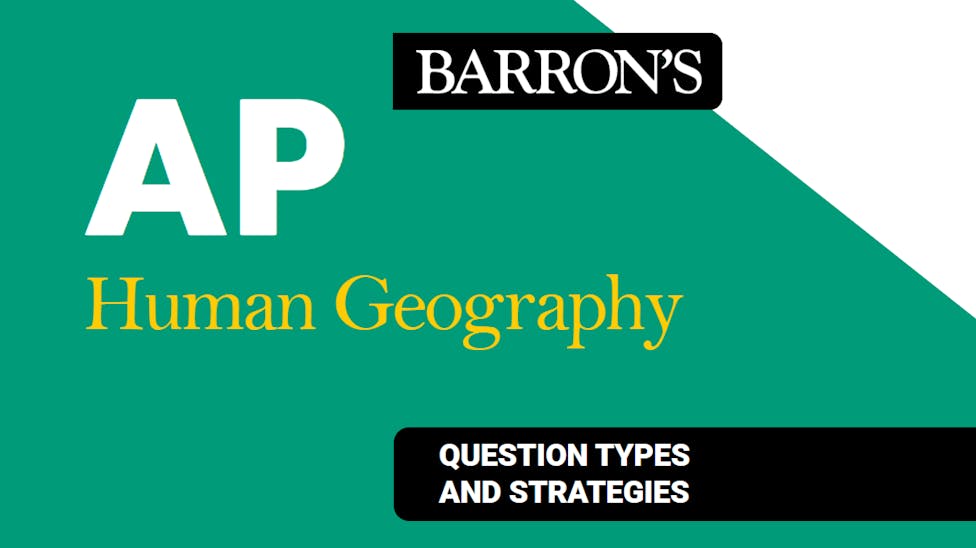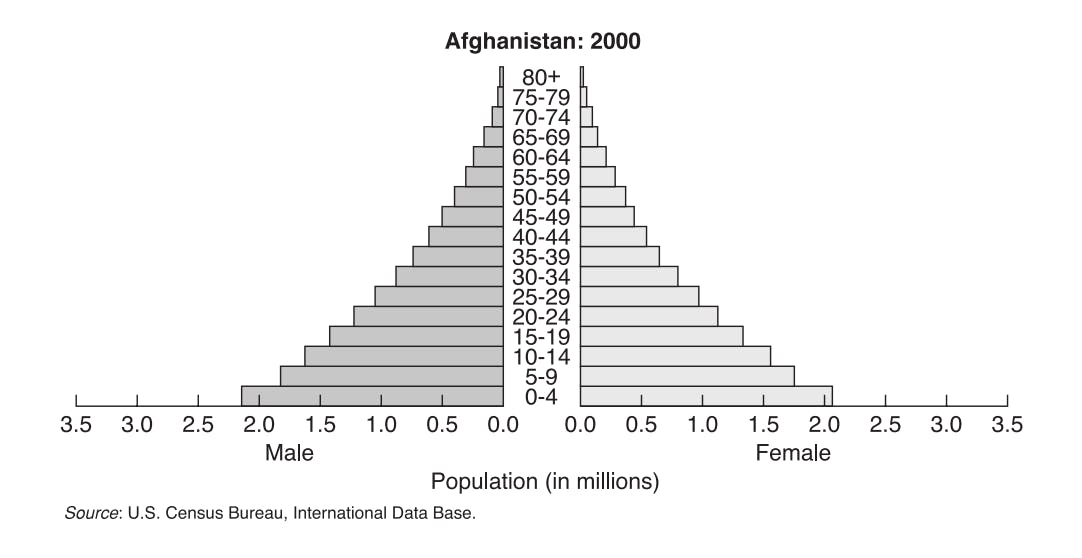AP Human Geography Question Types and Strategies
April 5, 2024

In addition to studying the content described in the AP Human Geography course, the best way to prepare for the exam is by actually answering questions similar to those that you will see on test day. The following are AP Human Geography exam strategies to help you become an effective test-taker. Practice using these strategies while taking AP Human Geography practice tests so they become second-nature for test day.
AP Human Geography Multiple-Choice Strategies
When taking the multiple-choice section of the exam, do not leave any blanks.
- Go through the entire set of multiple-choice questions and answer ONLY the ones you know for sure.
- When you reach a question you are not quite sure of, but think you can answer given more time, mark that question (devise a strategy that works best for you; perhaps you can circle the question number).
- After you have answered all the questions you know for sure, go back to the questions you circled. If you can narrow down the choices to two possible responses, go ahead and make your best guess.
- If time remains, scan through all the questions you marked with a circle and answer them.
Types of Multiple-Choice Questions on the AP Human Geography Exam
The following are different types of multiple-choice questions with examples of each type. Beginning with the 2020 exam, stimulus-based questions will make up close to half of all multiple-choice questions. A stimulus question, like the one below, involves interpretation of a map, graph, cartoon, chart, or other bit of data. The remaining questions will be a mix of the other types. Preparing yourself for different ways of being tested on similar content will enhance your ability to effectively answer questions on test day.
AP Human Geography Multiple-Choice Questions—Stimulus-Response: In these types of questions you are given a graph, cartoon, figure, map, or other bit of information that you must interpret before being able to correctly answer the question.

Based on this population pyramid, which of the following statements accurately describes Afghanistan’s most likely population pyramid in twenty years?
A. While growth is currently very rapid, in twenty years, it will have begun to stabilize, causing the base to narrow.
B. Most likely, the population pyramid will resemble the current figure, as the current large base will begin reproducing, causing an even larger base.
C. The top of the pyramid will begin to widen as the death rate begins decreasing.
D. The pyramid will look less like a pyramid and more like a rectangle as the larger base move up and fills in the middle.
E. The bottom of the pyramid will be narrower than the type showing the successful implementation of strict population policy.
AP Human Geography Multiple-Choice Questions—Definitional: These types of questions tend to be factual and test you on your ability to define particular concepts, processes, models, or theories.
Which of the following best defines a functional region?
A. The boundary including all areas within the circulation of a particular newspaper
B. The boundary including all people who speak Creole in Louisiana
C. The boundary around gerrymandered voting districts
D. The boundary that includes the American “Deep South”
E. The boundary encompassing the United States of America
AP Human Geography Multiple-Choice Questions—Cause-and-Effect Relationships: With these types of questions, you will be given a cause and asked to determine the correct effect from the possible responses given.
As a country becomes increasingly developed, economic activities become dominant in which sector?
A. Primary sector
B. Tertiary sector
C. Non-basic sector
D. Secondary sector
E. Basic sector
AP Human Geography Multiple-Choice Questions—Generalization: In a generalization question, you will be given a specific event, process, model, or theory, and you must be able to identify the general principle that came about as a result of that event, process, model, or theory.
The von Thunen model describes agricultural activity as it takes place in relation to the market. Which of the following statements generally represents the agricultural landscape according to the model?
A. Agricultural activity is solely determined by the longevity of the agricultural product.
B. Goods that are expensive to transport and spoil quickly must be located closer to the market.
C. Smaller agricultural goods like beans, herbs, and berries will be grown closer to the market than bigger goods like pumpkins.
D. Animals will be located closer to the market, like grazing cattle and hens, because they are difficult to move.
E. Agricultural goods that require more inputs, such as fertilizers and pesticides, will be grown closer to the market.
AP Human Geography Multiple-Choice Questions—Solution to a Problem: Solution problems tend to be combination questions; in this case you must first know the definition of a particular concept before being able to effectively solve the problem.
Which of the following economic enterprises is the best example of a footloose industry?
A. Shoe store
B. Jewelry store
C. Dance company
D. Cheese factory
E. Big box store
AP Human Geography Multiple-Choice Questions—Hypothetical Situation: In these types of questions, you put yourself in a hypothetical scenario and use your knowledge of certain principles to determine an appropriate response.
You decide to eat dinner at the local diner and get there right during the dinner rush when the restaurant is full of people. What is the most likely makeup of the group of diners?
A. You don’t recognize many of them so they must be mainly tourists, with a couple of familiar faces from the local area.
B. You don’t recognize too many faces, but they seem very neighborly so most of them probably come from the neighboring town because they don’t have a local diner, and the rest are from around town.
C. It’s probably about an equal mix of tourists, locals, and people from the neighboring towns.
D. You recognize most faces, but there are a few you don’t know, that are probably from the neighboring towns, and possibly a couple of tourists stopping through.
E. You probably don’t know most of the people since the diner is located at the intersection of two major freeways.
AP Human Geography Multiple-Choice Questions—Chronological Problem: Chronological problems are simply those that draw on your memory of the time period of certain notable events.
The Industrial Revolution took hold in England when?
A. Late 20th century
B. Late 19th century
C. Late 18th century
D. Early 20th century
E. Early 18th century
AP Human Geography Multiple-Choice Questions—Comparing/Contrasting Concepts and Events: In these types of questions you are asked to compare two events, processes, models, or concepts. As you answer these types of questions, define the two terms, processes, or events being compared before even looking at your options. This will spare you a lot of confusion.
India’s population policy differs from China’s in that
A. they aren’t different; they both strictly enforce a one-child-per-couple policy.
B. India is much more stringent, forcefully implementing their population policy.
C. China strictly adheres to a national population policy with benefits for those who conform and punishments for those who don’t, while India does not really have a policy.
D. India encourages rather than forces couples to limit the number of children they have.
E. China allows provinces to determine local strategies for implementing national policy, while India has one strict policy that the entire nation must abide by.
AP Human Geography Free-Response Question Strategies
Beginning with the May 2020 exam, the three free-response questions will each contain nine parts (a–g). One question will not have a stimulus, one question will have one stimulus (a graph, map, chart, picture, or reading), and one question will contain two stimuli. Each question will be worth 7 points (1 point/part, regardless of the difficulty of the part). Each of the nine parts will likely use one of five following task verbs:
- Compare: Provide an explanation or description of the similarities and/or differences between two things.
○ For example: Compare a country that conforms to the rank-size rule of urban areas to a country that has a primate city pattern. - Define: Provide a specific meaning for a given word, concept, or idea.
○ For example: Define the concept of distance decay. - Describe: Provide the relevant characteristics of a specified process or trend.
○ For example: Describe how the opening of China’s economy led to demographic shifts within China. - Explain: Provide information on how or why a pattern, process, or relationship occurs (use evidence or reasoning to support your explanation).
○ For example: Explain how a strict population policy, such as China’s former one-child-per-couple law, affects a country’s population pyramid. - Identify: Provide information on a specific pattern, process, or concept without elaboration or explanation.
○ For example: Identify one specific example of an effect of agribusiness on food production patterns in the United States.
When constructing your response, it is not necessary to provide the typical five-paragraph essay used in other humanities courses (introduction, paragraphs supporting the thesis statement, conclusion). Instead, you should focus on answering each of the three questions as directly and comprehensively as possible.
As you practice answering free-response questions, focus first on answering the question as accurately, clearly, and succinctly as possible. The readers are not evaluating you on your ability to construct an essay; they are simply looking for correct responses to each portion of the question! This means that you can receive full points for a response that is NOT a constructed essay as long as it contains correct responses/examples to each of the question’s elements. Make sure to provide only the information necessary to answer the question. For example, if the question asks you to define and provide an example of a particular concept or feature, provide only one definition and one example, as the reader will look only at the first definition/example provided. Your response should be written neatly with complete sentences and correct grammar (this makes it much easier for your reader to understand your communication).
When preparing for this portion of the exam, it is always good practice to take time to construct a brief outline that directly corresponds to the question. This will ensure that you address all parts of the question, and it will likely help you maintain organization as you construct your response.
AP Biology Resources
- About the AP Biology Exam
- Top AP Biology Exam Strategies
- Top 5 Study Topics and Tips for the AP Biology Exam
- AP Biology Short Free-Response Questions
- AP Biology Long Free-Response Questions
AP Psychology Resources
- What’s Tested on the AP Psychology Exam?
- Top 5 Study Tips for the AP Psychology Exam
- AP Psychology Key Terms
- Top AP Psychology Exam Multiple-Choice Question Tips
- Top AP Psychology Exam Free Response Questions Tips
- AP Psychology Sample Free Response Question
AP English Language and Composition Resources
- What’s Tested on the AP English Language and Composition Exam?
- Top 5 Tips for the AP English Language and Composition Exam
- Top Reading Techniques for the AP English Language and Composition Exam
- How to Answer the AP English Language and Composition Essay Questions
- AP English Language and Composition Exam Sample Essay Questions
- AP English Language and Composition Exam Multiple-Choice Questions
